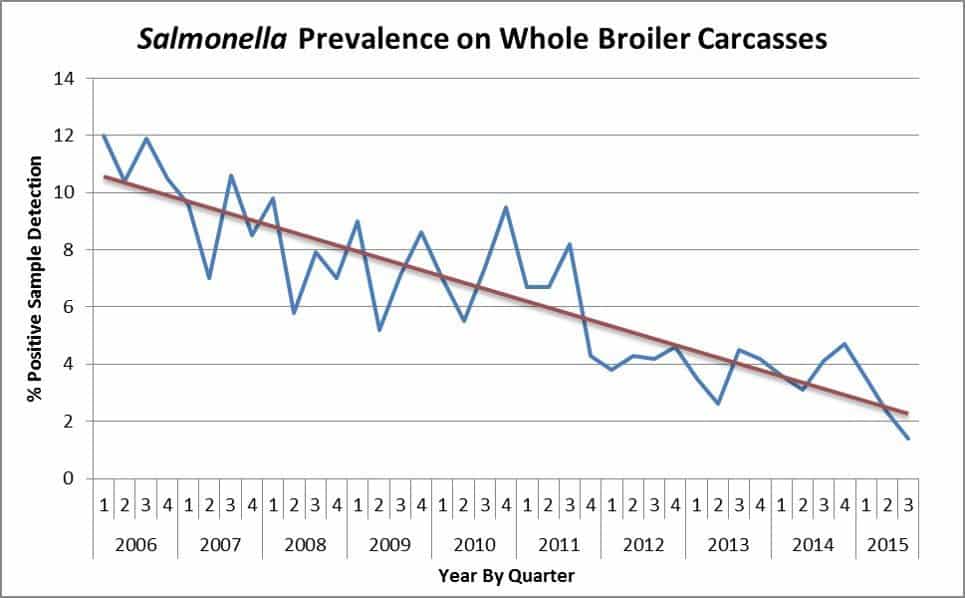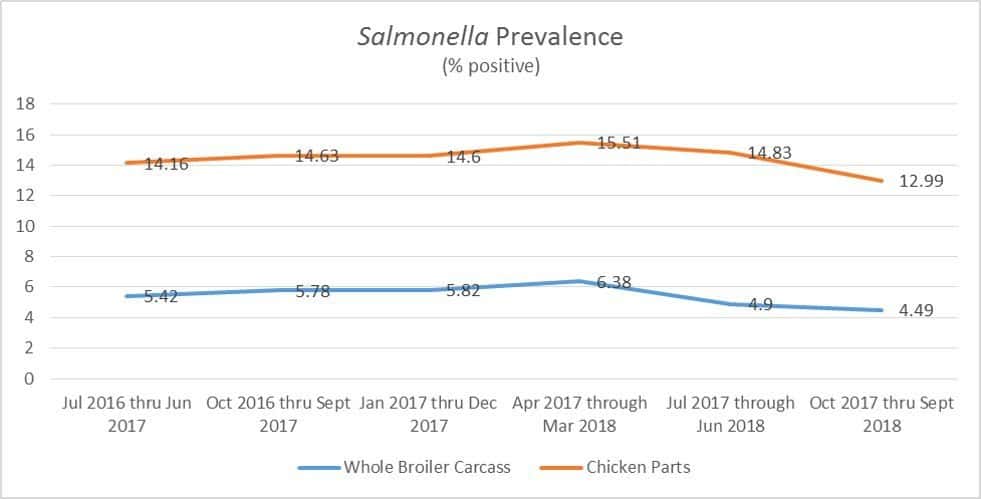History
In 1996, as part of the Pathogen Reduction; Hazard Analysis and Critical Control Point (HACCP) Systems; Final Rule, FSIS introduced the Salmonella verification program, which established pathogen reduction performance standards for a variety of FSIS-inspected product classes including whole broiler carcasses. These pathogen reduction performance standards were subsequently used to verify process control in meat and poultry processing establishments. For whole broiler carcasses, FSIS initially set the performance standard for Salmonella at 20% positive. (Given how FSIS calculated the standard, that meant that a maximum of 12 out of 51 samples could test positive to meet the performance standard). The broiler industry made significant progress in meeting and exceeding the 20% performance standard, and FSIS reduced the performance standard to 9.8% in 2011 (maximum number of 5 positives out of 51 samples to achieve the performance standard). According to FSIS verification data from 2006 through 2015 (chart below), the industry has continued to reduce the prevalence of Salmonella on whole broiler carcasses.
Source: FSIS verification data, 2006 -2015
What is a Performance Standard?
A performance standard is a metric that FSIS uses to evaluate potential presence of pathogens on poultry and other FSIS-regulated products. In the case for poultry, the pathogen is Salmonella. Although Salmonella is not an adulterant on raw poultry and all Salmonella is destroyed by cooking poultry to an internal temperature of 165°F, FSIS and the chicken industry are committed to reducing and controlling Salmonella on raw chicken. Potential Salmonella presence can be minimized with the use of proper sanitary dressing procedures, maintaining process control, and by the use of antimicrobial interventions during the production process. The performance standard metric determines only whether Salmonella is present or absent on the whole broiler carcass. It does not indicate how much Salmonella is present. In many cases the test can pick up a single cell of Salmonella, which would still result in a positive test. In addition, this metric does not determine which serotype of Salmonella may be present on the whole broiler carcass. According to the Centers for Disease Control (CDC), there are more than 2,500 serotypes for Salmonella, and of those less than 100 account for most human infections (from food as well as other sources). This does not mean that the presence of Salmonella is not taken seriously; it simply means that not all Salmonella are the same.
FSIS Sampling
FSIS samples (up to once a week) whole broiler carcasses, chicken parts (breast, wing, leg), and ground chicken for Salmonella at processing establishments to monitor an establishment’s process control over time. Whole broiler carcasses, chicken parts, and ground chicken all have their own separate performance standards (see below). Not only does FSIS take samples of whole broiler carcasses, chicken parts, and ground chicken, but the establishments themselves perform the same tests but at a much greater frequency. In fact, many establishments take well over 50 to 100 times more samples than does FSIS to ensure they are maintaining process control. Per FSIS regulations, broiler establishments are to take one paired whole broiler carcass sample for every 22,000 birds and establish processes to demonstrate process control. As a result, an establishment processing 1,000,000 birds per week would take 45 paired whole broiler carcass samples per week (90 samples total per week) compared to one sample per week by FSIS.
Testing alone does not ensure the safety of chicken. Testing is only one tool in the food safety toolbox, and it’s not even the main tool. Establishments employ dozens of intervention strategies as part of their food safety program including rigorous sanitation practices, good employee hygiene practices, sanitary dressing of the chickens, various rinses and washes that cleanse the chicken to reduce any potential foodborne pathogens or bacteria, and keeping the meat at the proper cool temperature. Microbiological tests are then conducted on chicken products by both the company and FSIS to help ensure that food safety systems are working properly. All chicken is safe if it is cooked to an internal temperature of 165°F.
FSIS Categories
FSIS uses its Salmonella sampling results to assess an establishment’s performance based on a three-category system. Establishments performing at or below half of the performance standard are placed in Category 1. Establishments that are equal to or less than the performance standard but above half of the performance standard are in Category 2. Establishments that are in Category 2 are still meeting the performance standard. An establishment in Category 3 is exceeding the Salmonella performance standard. The category breakdown between whole broiler carcasses, chicken parts, and ground chicken can be found in the chart below:
How are Categories Calculated?
FSIS uses a 52-week window to calculate categories. The number of samples taken by FSIS in a 52-week window serves as the denominator. The number of samples tested positive for Salmonella serves as the numerator. Several examples for whole broiler carcasses categories are outlined below. Note how influential the number of samples taken by FSIS is to an establishment’s category status even when the number of positive samples remains the same.
How is the Industry Doing?
The broiler chicken industry is focused on prevention and continuous improvement and the industry’s food safety record demonstrates just that. FSIS frequently updates microbiological testing data, category status, and other related information on their website. If you were to look at the most recent posting of FSIS testing results depicting the prevalence of Salmonella on whole broiler carcasses and chicken parts, you would see that the industry is at an all-time low for Salmonella on chicken parts. Additionally, you would see that the industry continues to make progress at reducing Salmonella prevalence on whole birds over the last six months (see graph below):
Regarding categories, if you were to look at the most recent posting of categories by broiler establishment, you would see that over 85% of the industry is meeting the FSIS performance standard for Salmonella on whole broiler carcasses. Similarly, over 70% of broiler establishments are meeting the FSIS performance standard for Salmonella on chicken parts.
Conclusion
A poultry company’s food safety strategy starts long before the bird even gets to the establishment. Government testing at the establishment is one of the many instruments in place as part of that overall strategy to make chicken products as safe as possible before it reaches our customers. The bottom line is that whether an establishment is a Category 1, 2 or 3, all chicken is safe to eat when it is properly handled and cooked to an internal temperature of at least 165°F. For more information about safe handling and cooking tips, as well was what the poultry industry is doing to keep products safe, please visit the National Chicken Council’s Chicken Check In website.
*A printable .pdf version of this white paper is available by clicking here.







